On August 22, the 'smoke started a series of articles in celebration of Ray Bradbury's 90th birthday. The Toronto Film Festival waylaid plans to publish the second half of the series, so we're picking it up where we left off one month earlier.
Besides, it's still technically August on Mars, a planet Bradbury has written about on several occasions. And really, is there a bad time to pay tribute to a writer as influential as Ray Bradbury? As long as it's autumn, a season important to the author and his work, we figure there's no harm in turning "Ray Bradbury Week" into "Ray Bradbury Week and a Few Months."
I'm actually kind of glad the Bradbury series ended up getting pushed back - what better way to enter October and the Pink Smoke's month of horror-themed articles than a review of the author's celebration of all things Halloween? Still, I was hesitant to see the animated version of The Halloween Tree for the same reason I had avoided Disney's Something Wicked This Way Comes for years: I'm so familiar with the story, I didn't want my vision of it somehow corrupted by a cast and crew not specifically selected and approved by my own imagination. Moreso, I was pretty sure it would be terrible. Even though Bradbury himself had written the adaptation, the Rugrats-looking cover was not reassuring. As I mentioned before, Halloween Tree originated as a project Bradbury had written for his friend Chuck Jones in 1967 that ultimately fell through. Besides his obvious qualification as the greatest director of animated television who ever lived or will ever live, Jones also made How the Grinch Stole Christmas, the best holiday special of all time. The resulting book, originally published in 1972, is filled with imagery Jones would have translated brilliantly to the screen: colorful characters, elaborate settings and mosaic storytelling. The adaptation was finally produced for the Turner Network in 1993 by Hanna-Barbera, whose work Jones once referred to dismissively as "animated radio." Mario Piluso, a first-time director whose design credits include the sacrilegious sequels to Charlotte's Web and The Secret of NIMH, was not the kind of ideal choice that Chuck Jones was. But they had the VHS at the library, so I figured I'd give it a shot.
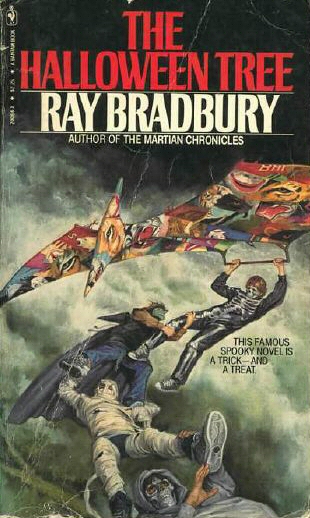 The book emerged from Bradbury's love of A Christmas Carol, and his desire to write a similar time-spanning pastiche that celebrated the origins and meaning of Halloween, his favorite holiday. Like Something Wicked, the protagonists are 12-year-old boys who come to appreciate their young lives in the face of morality, the stake in this case being Pipkin, the liveliest member of the group, who lies in a hospital bed on Halloween night in danger of succumbing to appendicitis. Pipkin's costumed friends chase a fragment of him (simplified to his "soul" in the cartoon version) with the help of the mysterious Carapace Clavicle Moundshroud, owner of a magnificent spooky mansion complete with the pumpkin-growing "Halloween Tree," through different eras of the past, all historical harbingers to Halloween (the days of Egyptian mummification, Celtic druid ceremonies, the Day of the Dead in Mexico etc). From beginning to end, the book is guilty of the kind of verbal over-enthusiasm that mars some of the more tedious passages of Something Wicked: Bradbury in the 70's, in the words of Stephen King, tended to "not so much write about a topic as to bulldoze it into the ground." But that kind of purple prose is undeniably fun to read, sweeping the reader into the story and barreling downhill at a pell mell pace that doesn't let up until the final page, leading me to question whether a film version of the story could possibly move at the same breakneck pace while keeping my interest.
The book emerged from Bradbury's love of A Christmas Carol, and his desire to write a similar time-spanning pastiche that celebrated the origins and meaning of Halloween, his favorite holiday. Like Something Wicked, the protagonists are 12-year-old boys who come to appreciate their young lives in the face of morality, the stake in this case being Pipkin, the liveliest member of the group, who lies in a hospital bed on Halloween night in danger of succumbing to appendicitis. Pipkin's costumed friends chase a fragment of him (simplified to his "soul" in the cartoon version) with the help of the mysterious Carapace Clavicle Moundshroud, owner of a magnificent spooky mansion complete with the pumpkin-growing "Halloween Tree," through different eras of the past, all historical harbingers to Halloween (the days of Egyptian mummification, Celtic druid ceremonies, the Day of the Dead in Mexico etc). From beginning to end, the book is guilty of the kind of verbal over-enthusiasm that mars some of the more tedious passages of Something Wicked: Bradbury in the 70's, in the words of Stephen King, tended to "not so much write about a topic as to bulldoze it into the ground." But that kind of purple prose is undeniably fun to read, sweeping the reader into the story and barreling downhill at a pell mell pace that doesn't let up until the final page, leading me to question whether a film version of the story could possibly move at the same breakneck pace while keeping my interest.
Before finding out I first had to wade through almost 40 minutes worth of previews and shorts on the video, using archaic fast forward technology since Warner Brothers hasn't released this on dvd yet. My worst fears about the movie's chances seemed validated by obnoxious and poorly-animated spots for the eighth or ninth Land Before Time sequels and The Swan Princess, reminding me that the early 90's marked the resurgence of the Disney empire and the pitiful decline of former employees-turned-competitors Richard Rich and Don Bluth (turns out we were all just waiting for Pixar). After two full Yogi Bear cartoons (to be fair, one of them was Halloween-themed), the film finally started and I was relieved to hear Bradbury's voice narrating the opening frames, a nice surprise. The narration used in the film is really well written, not all passages are recycled from the book, and even though some of it feels unnecessary in helping to follow the narrative the author's pre-stroke, natural-storyteller voice always sounds the way the movie should make you feel. Sometimes the scenes keep up with Bradbury's enthusiasm, sometimes they lag behind a bit.
The movie scales the gang of kids down from eight to four. The character dressed as a witch is changed to a girl, which makes makes more sense: have you ever known a male to dress as a witch outside of a Fall Ball Halloween Gala setting? That always throws me off a little in the book, not that I'm questioning that character's life choices. I was curious how they were going to handle the introductions of the characters, as one of the cool aspects of the book is that none of the friends recognize each other in their disguises so we meet the characters gradually through the course of the story, learning the last character's name for the first time in the fifteenth or sixteenth chapter. Of course to make it more accessible the four kids in the movie are all introduced individually by name as they're preparing to meet their friends for trick or treating. They're more conventionally stereotyped - nerd, fat kid, female - but Bradbury gives them all believable personalities and makes you remember them past the costumes they wear, which is the only thing you have to go on in the book.* There are some forced character arcs - the girl is scared of heights and later has to face a situation where she overcomes her fear to save her friends, young Tom Skelton is jealous of Pipkin's role as the group's appointed leader - but nothing too egregious. I was curious to hear the music the filmmakers would set Bradbury's lyrics to, but surprisingly there's no singing whatsoever in this children's movie, although the score by John Debney (who would go on to compose music for everything from The Passion of the Christ to Machete) is very good.
Although the character design and foreground animation is largely subpar, there are a number of gorgeous, painterly backgrounds throughout the movie, especially in the opening sequences that establish the deep oranges and browns of Bradbury's mid-autumn mid-American town, which the Something Wicked movie failed to do with its obvious sets and off-camera propmen dropping leaves into frame. There are a number of shot compositions surprising to see in an animated television movie: overhead angles with a hanging street light in the center, panoramas capturing both sides of the central square, POV shots of dastardly-looking pumpkins dangling menacingly from the branches of the titular tree. The best sequence, not surprising since it lends itself to such colorful animation, is the construction of the giant kite Moundshroud and the kids use to transport themselves into the past, magically forged from circus posters of vicious animals that come to life as their images are incorporated into the impromptu aircraft (the children make up the tail). This is just the kind of sequence I would kill to have seen Chuck Jones try his hand at, but director Piluso does his best and occasionally pulls off some amazing moments like the shot of a fireball landing in the middle of Stonehenge, elongating the shadows of the prehistoric monument so they reach every corner of the surrounding field.
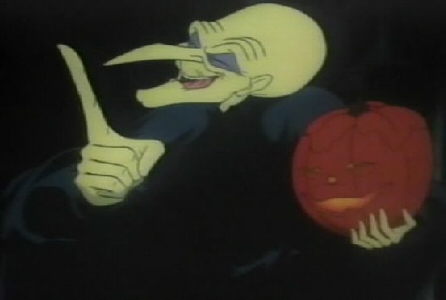
Leonard Nimoy does great work as the sinister Mr. Moundshroud, serving up his best voicework next to the Star Trek animated series and his appearances on "The Simpsons." He's so grunty as to be nearly unrecognizable (definitely not Spock here). While I had pictured more of a skeletal Lon Chaney/Peter Cushing type old man from his description in the book, the animators decided to make him more demonic in appearance, with green skin, exaggerated pointy nose and elongated fingers. Moundshroud as a character is portrayed much more villainous than in the book, where he's really just a mystical guide who turns out to be an impartial embodiment of death (that is, not particularly threatening to the protagonists). Again, for the sake of a more linear storyline with good guy/bad guy dynamic, Bradbury has Pipkin's soul - carrying a glowing pumpkin in his likeness representative of his lifeforce - being chased by Moundshroud, a cranky Scrooge/Gargamel surrogate who points out the history of Halloween to his fellow travelers almost as an aside as he tries to get his clammy hands on Pipkin to trap him inside the gourd for permanent placement on his tree. Making Moundshroud more evil sets up a nice touch where he's forced to move back as Notre Dame builds itself and its shadow grows longer: it pains him to be even in the casting shade of the grand cathedral. It also makes the kids seem more heroic where at the end, when Moundshroud has trapped Pipkin, it becomes their suggestion to give up a year of their lives in exchange for his (in the book Moundshroud offers this proposal).
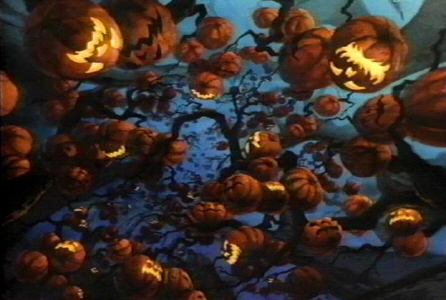
Other changes from the novel are more obvious considering the movie's responsibilities as a children's cartoon. Bradbury's vague criticism of Christianity ("Now the Christians come and cut the Romans down — new altars, boys, new incense, new names," Moundshroud explains as the children witness the fall of paganism) and sympathy for persecuted druids and wiccas over the ages are nowhere to be found. There's no scene with Samhain, the scythe-wielding druidic god of death who reshaped pleading souls into the forms of creatures, although the animated characters do talk about dead people being brought back as animals and Pipkin turns into a cat. But the decision to cast Moundshroud as more of an antagonist creates more tension, like death itself is threatening Pipkin and his friends, and an altered scene where the kids have to actively rescue Pipkin before he's mummified and buried alive is fairly intense. They also end up having dinner with a dead person in another scene unique to the adaptation. Of course the book's casual chronicling of the gang's visits to various different places would feel too travelogue-y as a screenplay, so all the changes more or less make sense. Bradbury manages to maintain his basic theme - how basic fear of death led to the creation of Halloween, a festival in which we allow ourselves to make light of said fear - it's just given a sense of urgency when placed in a more action-oriented narrative. Death is no longer a part of life the boys have to learn about, it's something that's coming to get them (even while it's teaching them the history of their favorite holiday). In that sense, the movie is able to share the book's frenzied pace but in an entirely different way, following the exciting events (as well as condensing the book into its trim 70 minute running time, with fade-ins and outs to designate commercial breaks) rather than gorging on mutli-detailed sketches of everything the kids are seeing. Bradbury's rampant descriptions ("beware his descriptions!") are so excessively galvanized I'm actually surprised he didn't have a heart attack writing the book. It was never going to be easy for a movie to imitate that same kind of narrative imperativeness, even when its only job is to follow the rousing action, but Piluso does a satisfactory job.
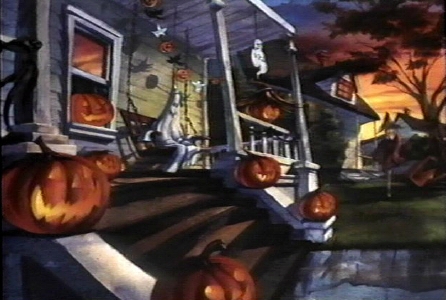
I really wish the characters looked better. Both Pipkin and Tom Skelton have kind of featureless lanky forms and are discernible from one another by hair color only. The costumes, such an important part of the story (each costume in the book corresponds to the period they're visiting, mummy=Egypt, skeleton=Day of the Day and so forth), aren't very impressive and seem like an afterthought by the design team. And I don't understand, if the Notre Dame sequence was going to be left in, why the fat kid is dressed as a furry monster rather than a gargoyle like in the book. Still, the movie has good moments that make up for it, like when the girl is pulling her bike up the edge of her basement steps. Watching it, I thought "That bike's not going to make it up there!...Oh that's right this is a cartoon." So nice work pulling a fast one on me there, movie. It's worth viewing if only for Bradbury's wonderful narration and script, which won a Daytime Emmy for Outstanding Writing in an Animated Program. Not to devalue the award - Bradbury deserves as many accolades as you can throw at him - but he probably won on the strength of his name alone, coupled with the convenience of only having to mold one Emmy instead of the nine they would have had to hand out to the writing staff of "Animaniacs," Bradbury's only competition in that category (also I think we can all agree that "Animaniacs" had gotten pretty stale by 1993**). It would have been thrilling to see this same screenplay turned into an epic live film action by a young, hungry, Frankenweenie-era*** Tim Burton before his work became infuriatingly derivative.
A sad addendum: On Halloween 1993, the same month The Halloween Tree debuted on The Cartoon Network, Bradbury's good friend Federico Fellini died. Bradbury took down all his decorations and refused to celebrate out of respect for the famed Italian filmmaker: in the author's words, "all of a sudden Halloween had become too real."
~ OCTOBER 4, 2010 ~

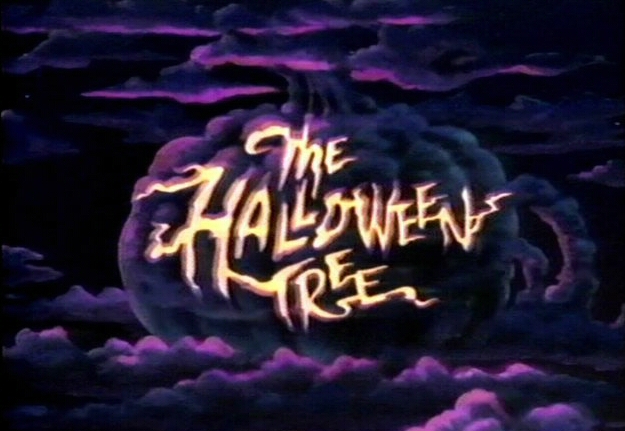
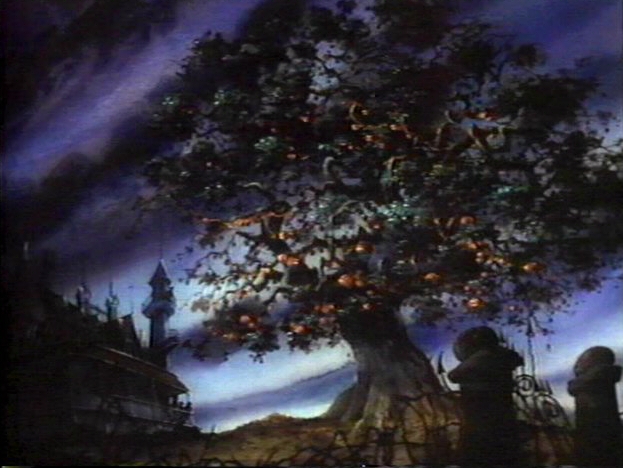
 The book emerged from Bradbury's love of A Christmas Carol, and his desire to write a similar time-spanning pastiche that celebrated the origins and meaning of Halloween, his favorite holiday. Like Something Wicked, the protagonists are 12-year-old boys who come to appreciate their young lives in the face of morality, the stake in this case being Pipkin, the liveliest member of the group, who lies in a hospital bed on Halloween night in danger of succumbing to appendicitis. Pipkin's costumed friends chase a fragment of him (simplified to his "soul" in the cartoon version) with the help of the mysterious Carapace Clavicle Moundshroud, owner of a magnificent spooky mansion complete with the pumpkin-growing "Halloween Tree," through different eras of the past, all historical harbingers to Halloween (the days of Egyptian mummification, Celtic druid ceremonies, the Day of the Dead in Mexico etc). From beginning to end, the book is guilty of the kind of verbal over-enthusiasm that mars some of the more tedious passages of Something Wicked: Bradbury in the 70's, in the words of Stephen King, tended to "not so much write about a topic as to bulldoze it into the ground." But that kind of purple prose is undeniably fun to read, sweeping the reader into the story and barreling downhill at a pell mell pace that doesn't let up until the final page, leading me to question whether a film version of the story could possibly move at the same breakneck pace while keeping my interest.
The book emerged from Bradbury's love of A Christmas Carol, and his desire to write a similar time-spanning pastiche that celebrated the origins and meaning of Halloween, his favorite holiday. Like Something Wicked, the protagonists are 12-year-old boys who come to appreciate their young lives in the face of morality, the stake in this case being Pipkin, the liveliest member of the group, who lies in a hospital bed on Halloween night in danger of succumbing to appendicitis. Pipkin's costumed friends chase a fragment of him (simplified to his "soul" in the cartoon version) with the help of the mysterious Carapace Clavicle Moundshroud, owner of a magnificent spooky mansion complete with the pumpkin-growing "Halloween Tree," through different eras of the past, all historical harbingers to Halloween (the days of Egyptian mummification, Celtic druid ceremonies, the Day of the Dead in Mexico etc). From beginning to end, the book is guilty of the kind of verbal over-enthusiasm that mars some of the more tedious passages of Something Wicked: Bradbury in the 70's, in the words of Stephen King, tended to "not so much write about a topic as to bulldoze it into the ground." But that kind of purple prose is undeniably fun to read, sweeping the reader into the story and barreling downhill at a pell mell pace that doesn't let up until the final page, leading me to question whether a film version of the story could possibly move at the same breakneck pace while keeping my interest.

